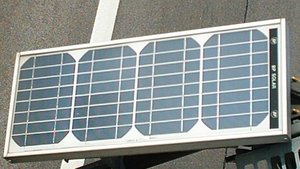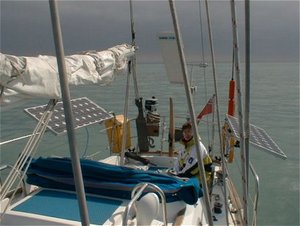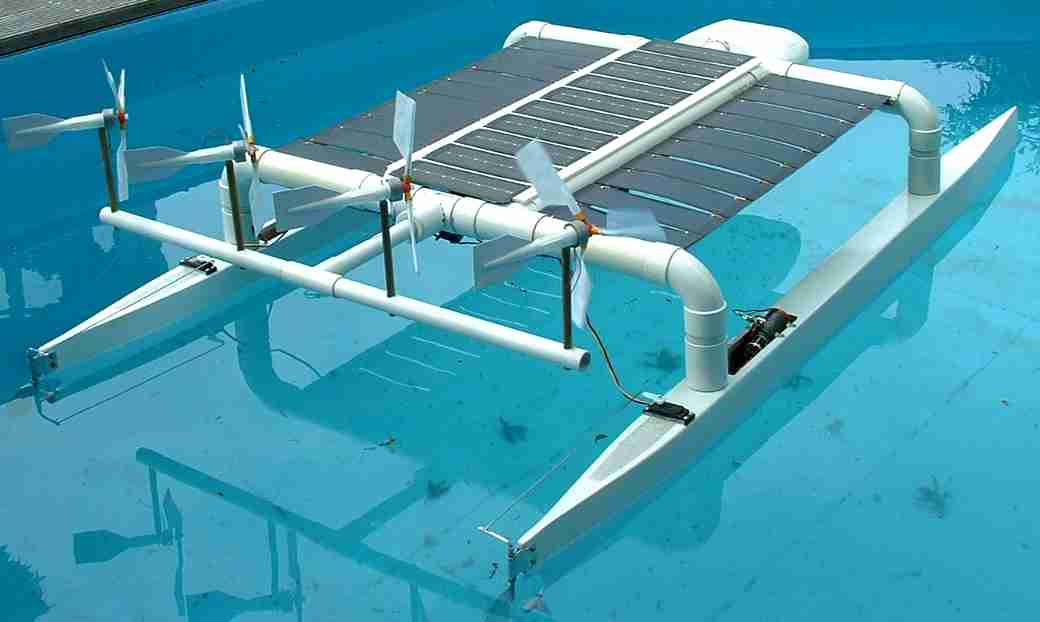|
SOLAR PANELS - SUPPLIERS & MANUFACTURERS A - Z
|
||||||||||||||||||||||||||||||||||||
|
HOME | INDEX | AUTOMOTIVE | BLUEBIRD | ELECTRIC CARS | E. CYCLES | SOLAR CARS |
||||||||||||||||||||||||||||||||||||
|
"The
supply of solar energy is both without limit and cost;
Solar panels are devices for capturing the energy in sunlight. Solar photovoltaic panels contain arrays of solar cells that convert light into electricity. They are called solar after the sun or "Sol" because the sun is the most powerful source of the light available for use. The solar cells are sometimes called photovoltaic cells, photovoltaic meaning literally "light-electricity". Solar cells or PV cells rely on the photovoltaic effect to absorb the energy of the sun and cause current to flow between two oppositely charged layers.
Solar panel
The thermal energy of sunlight can also be captured and used for water heating and space heating; various active solar methods are used to collect heat from sunlight and store it for later use.
Solar panels make up a very small portion of the world's electricity production, held back by the higher cost per watt compared to fossil fuels - as much as 10 times higher, depending on the circumstances. They have become routine in certain limited applications, such as powering buoys or devices in deserts and other remote areas, and in experimental form they have even been used to power automobiles in races such as the World solar challenge across Australia. Large-scale incentive programs, offering taxpayer-supported financing and incentives, have greatly accelerated the pace of solar PV installations in Germany, Japan, the United States and other countries.
Currently the costs associated with solar electric panels make them uneconomic in applications where conventional "grid" power is readily available. As fossil fuel energy costs climb, and production experience reduces production costs of the solar cells, this may not be true in the relatively near future. Also many installations are driven by tax breaks and green sensibilities.
World solar power production
Total peak power of solar panels is around 1800 MW as of 2004. [1] Significant solar photovoltaic power has been installed in many countries[2]:
Solar panel on this yacht charges 12V batteries at up to 9A in direct sunlight
Theory and Construction
See the article solar cell for a description of the conversion of light energy into electrical energy. Crystalline silicon and gallium arsenide are typical choices of materials for solar cells. Gallium arsenide crystals are grown especially for photovoltaic use, but silicon crystals are available in less-expensive standard ingots, which are produced mainly for consumption in the microelectronics industry. Polycrystalline silicon has lower conversion efficiency but also lower cost.
When exposed to direct sunlight at 1 AU, a 6-centimeter diameter silicon cell can produce a current of about 0.5 ampere at 0.5 volt. Gallium arsenide is more efficient.
Crystalline ingots are sliced into wafer-thin disks, polished to remove slicing damage, dopants are introduced into the wafers, and metallic conductors are deposited onto each surface: a thin grid on the sun-facing side and usually a flat sheet on the other. Solar panels are constructed of these cells cut into appropriate shapes, protected from radiation and handling damage on the front surface by bonding on a cover glass, and cemented onto a substrate (either a rigid panel or a flexible blanket). Electrical connections are made in series-parallel to determine total output voltage. The cement and the substrate must be thermally conductive, because the cells heat up from absorbing infrared energy that is not converted to electricity. Since cell heating reduces the operating efficiency it is desirable to minimize the heating. The resulting assemblies are called solar panels or solar arrays.
A solar panel is a collection of solar cells. Although each solar cell provides a relatively small amount of power, many solar cells spread over a large area can provide enough power to be useful. To get the most power, solar panels have to be pointed directly at the sun.
Solar panels on spacecraft
Probably the most successful use of solar panels is on spacecraft, including most spacecraft that orbit the Earth and Mars, and spacecraft going to other destinations in the inner solar system. In the outer solar system, the sunlight is too weak to produce sufficient power and radioisotope thermal generators are used.
Research is underway to develop solar power satellites: space-based solar plants — satellites with large arrays of photovoltaic cells that would beam the energy to Earth using microwaves or lasers. Japanese and European space agencies have announced plans to develop such power plants in the first quarter of the 21st century.
As opposed to chemical rockets, which are powered by a chemical reaction of the propellant, and uses the exhaust gases as reaction mass, some spacecraft propulsion methods have a method of expelling reaction mass powered by electricity. Either solar energy or nuclear energy is used. These methods typically have a higher specific impulse. The amount of reaction mass needed always grows exponentially with the delta-v to be produced, but more mildly if the specific impulse is high (but it should not be too high because for large specific impulse the power needed is proportional to it). With solar power the acceleration that can be produced is very low (much too low for a launch), but enduring. Typical burn times are months instead of minutes. The power the solar panel produces per kg, as an upper limit of the power the spacecraft has at its disposal per kg spacecraft (including solar panels) is an important factor. See also energy needed for propulsion methods.
Solar panels need to have a lot of surface area that can be pointed towards the Sun as the spacecraft moves. More exposed surface area means more electricity can be converted from light energy from the Sun. Sometimes, satellite scientists purposefully orient the solar panels to "off point," or out of direct alignment from the Sun. This happens if the batteries are completely charged and the amount of electricity needed is lower than the amount of electricity made. The extra power will just be vented by a shunt into space as heat.
Spacecraft are built so that the solar panels can be pivoted as the spacecraft moves. Thus, they can always stay in the direct path of the light rays no matter how the spacecraft is pointed. Spacecraft are usually designed with solar panels that can always be pointed at the Sun, even as the rest of the body of the spacecraft moves around, much as a tank turret can be aimed independently of where the tank is going. A tracking mechanism is often incorporated into the solar arrays to keep the array pointed towards the sun.
Solar panel array on the Solar Navigator development model
Solar power for propulsion is currently used on the European lunar mission SMART-1 with a Hall effect thruster. Solar array mass could be reduced with thin-film photovoltaic cells, flexible blanket substrates, and composite support structures. Solar array efficiency could be improved by using new photovoltaic cell materials and solar concentrators that intensify the incident sunlight.
Photovoltaic concentrator solar arrays for primary spacecraft power are devices which intensify the sunlight on the photovoltaics. This design uses a flat lens, called a Fresnel lens, which takes a large area of sunlight and concentrates it onto a smaller spot. The same principle is used to start fires (or burn ants!) with a magnifying glass on a sunny day.
Solar concentrators put one of these lenses over every solar cell. This focuses light from the large concentrator area down to the smaller cell area. This allows the quantity of expensive solar cells to be reduced by the amount of concentration. Concentrators work best when there is a single source of light and the concentrator can be pointed right at it. This is ideal in space, where the Sun is a single light source. Solar cells are the most expensive part of solar arrays, and arrays are often a very expensive part of the spacecraft. This technology allows costs to be cut significantly due to the utilization of less material.
LINKS and REFERENCES
http://www.tectosol.staticip.de/index_en.htm Solar electricity yield of photovoltaic system http://www.solarbuzz.com/ Solarbuzz tracks the price of industrial solar panels http://www.californiasolarco.com/power-systems-photo-gallery.html Residential systems http://www.tucsonelectric.com/ Tucson Electric Power 2.4 MW array at Springerville Use of solar cells in Kenya and Uganda, in Africa Pennicott, Katie, "Solar cell edges towards endless energy". PhysicsWeb. Dye Sensitized Solar Cells (DYSC) based on Nanocrystalline Oxide Semiconductor Films News searching: Solar Cell, Photovoltaic Historical: Photovoltaic Solar Energy Conversion: An Update Wladek Walukiewicz, Materials Sciences Division, Berkeley Lab.: Full Solar Spectrum Photovoltaic Materials Identified. Quote: "... Maximum, theoretically predicted efficiencies increase to 50%, 56%, and 72% for stacks of 2, 3, and 36 junctions with appropriately optimized energy gaps, respectively...." CNET: 5/12/03 SunPower Announces World's Most Efficient, Low-Cost Silicon Solar Cell Quote: "...The National Renewable Energy Laboratory (NREL) has verified 20.4 percent conversion efficiency for the A-300...." SunPower A-300 (pdf), SunPower 29 March 2002, Scientists Create New Solar Cell Quote: "...semiconducting plastic material known as P3HT... 1.7 percent for sunlight..." 15 February 03, 'Denim' solar panels to clothe future buildings Quote: "... Unlike conventional solar cells, the new, cheap material has no rigid silicon base..." Residential Solar Power Systems - Photo Gallery Examples of Photovoltaic Systems azonano.com: Carbon Nanotube Structures Could Provide More Efficient Solar Power for Soldiers 28 February 2005
Healthier alternative tastes for adventure capitalists
Solar Red | Solar Crush + | Solar Cola | Solar Citrus + | Solar +
|
||||||||||||||||||||||||||||||||||||
|
AUTOMOTIVE | BLUEBIRD | SOLAR CAR RACING TEAMS | SOLAR CAR RACING TEAMS | SOLAR CARS |
||||||||||||||||||||||||||||||||||||
|
The content
of this website is copyright © and design copyright 1991 and 2007
Electrick Publications and NJK. All rights reserved. The bluebird logo |
||||||||||||||||||||||||||||||||||||



